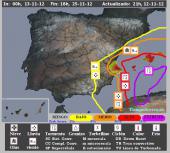Letra L
- L - Laminar - Smooth, non-turbulent. Often used to describe cloud formations which appear to be shaped by a smooth flow of air traveling in parallel layers or sheets. Laminar - Liso, no turbulento. A menudo usado para describir formaciones nubosas que parecen ser formadas por un flujo de aire liso que viaja en estratos paralelos o láminas. Landspout - [Slang], a tornado that does not arise from organized storm-scale rotation and therefore is not associated with a wall cloud (visually) or a mesocyclone (on radar). Landspouts typically are observed beneath Cbs or towering cumulus clouds (often as no more than a dust whirl), and essentially are the land-based equivalents of waterspouts. Landspout (tuba de tierra) - [Construcción vulgar], tornado que no surge de una rotación organizada a escala de la tormenta y por tanto no está asociado a una nube-pared o wall-cloud (visualmente) o a un mesociclón (en el radar). Los landspouts normalmente se observan bajo Cbs o coliflores (a menudo como no más de un remolino de polvo) y, esencialmente, son los equivalente de tierra de los waterspouts (tuba de agua). Flanking Line - A line of cumulus or towering cumulus clouds connected to and extending outward from the most active part of a supercell, normally on the southwest side. The line normally has a stair-step appearance, with the tallest clouds closest to the main storm, and generally coincides with the pseudo-cold front. See HP storm, and supercell. Dry Line - A boundary separating moist and dry air masses, and an important factor in severe weather frequency in the Great Plains. It typically lies north-south across the central and southern high Plains states during the spring and early summer, where it separates moist air from the Gulf of Mexico (to the east) and dry desert air from the southwestern states (to the west). The dry line typically advances eastward during the afternoon and retreats westward at night. However, a strong storm system can sweep the dry line eastward into the Mississippi Valley, or even further east, regardless of the time of day. A typical dry line passage results in a sharp drop in humidity (hence the name), clearing skies, and a wind shift from south or southeasterly to west or southwesterly. (Blowing dust and rising temperatures also may follow, especially if the dry line passes during the daytime; see dry punch). These changes occur in reverse order when the dry line retreats westward. Severe and sometimes tornadic thunderstorms often develop along a dry line or in the moist air just to the east of it, especially when it begins moving eastward. See LP storm. NSSL - National Severe Storms Laboratory, in Norman OK. (Sometimes pronounced NES-sel.) LNTS - Laboratorio Nacional de Tormentas Severas, en Norman OK. (En inglés, NSSL, a veces pronunciado nes-sel).
|
© Spain Severe Weather 2010








